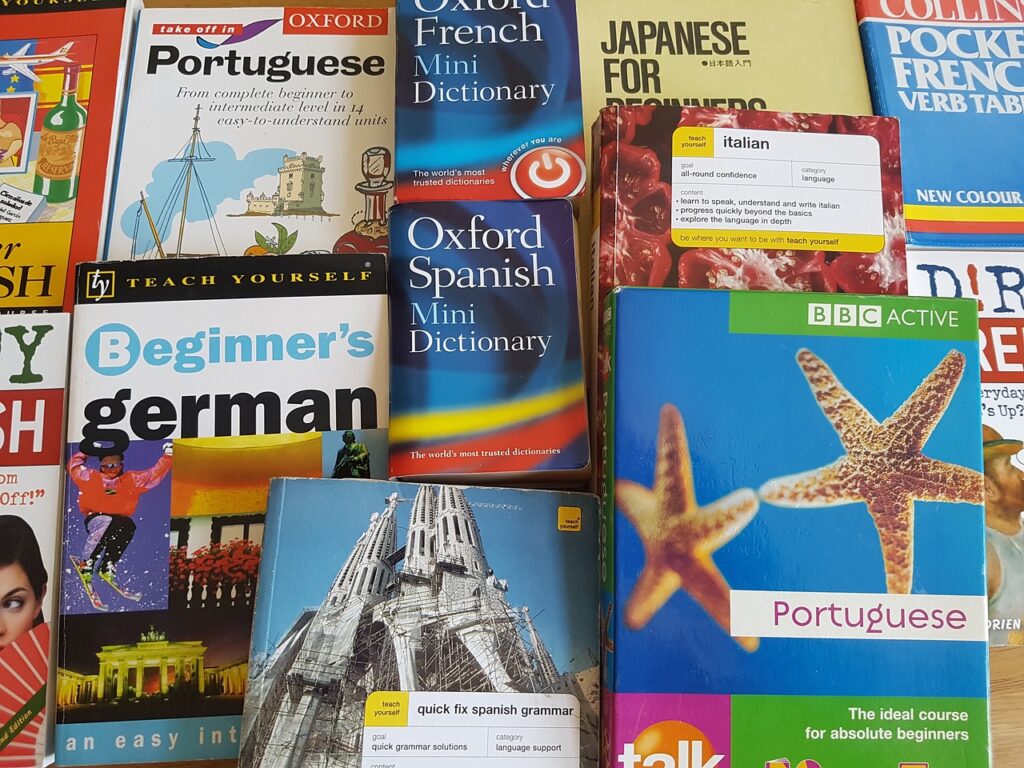Strategies for Language Anxiety. This Post helps the User to understand what the Problem is and how to change it into positive outcome.
Not exactly your Problem? Click here to see more about Overcoming Language Learning Problems.
Strategy 1: Embrace Progressive Exposure
Language anxiety often stems from fear of the unknown or unfamiliarity with a new language. One effective strategy to overcome this anxiety is to embrace progressive exposure. Instead of overwhelming yourself with the entire language at once, take small, manageable steps.
Start by focusing on basic, everyday phrases and gradually expand your vocabulary and language skills. Begin with simple greetings, common expressions, and fundamental vocabulary. As you become more comfortable, progressively introduce more complex structures and topics.
This gradual approach allows you to build confidence at each stage of your language learning journey. Celebrate small victories and acknowledge your progress, reinforcing a positive mindset that counteracts language anxiety. By embracing progressive exposure, you’ll find that language learning becomes a more enjoyable and less intimidating experience.
Furthermore, incorporate the principle of progressive exposure into your daily routine. Dedicate specific time slots each day to practice and immerse yourself in the language, gradually increasing the duration as you become more accustomed. This consistent exposure helps normalize the language-learning process, making it a regular and less daunting part of your life.
Utilize language-learning apps, podcasts, or online resources that provide structured lessons tailored to your proficiency level. These tools often employ a progressive curriculum, guiding you through foundational concepts before advancing to more intricate linguistic elements.
Additionally, consider joining language exchange groups or communities, where you can engage in gradual conversations with native speakers or fellow learners. This exposure not only enhances your language skills but also familiarizes you with different accents, dialects, and conversational styles, contributing to a well-rounded language proficiency.
Remember, the key is to approach language learning as a gradual and evolving journey rather than a rushed destination. By embracing progressive exposure and building linguistic resilience, you’ll find that language anxiety diminishes as you grow more confident in your linguistic abilities, paving the way for a successful and fulfilling language-learning experience.
In summary, the strategy of embracing progressive exposure involves taking gradual steps, incorporating diverse language materials, participating in real-life interactions, and setting achievable goals. By making language learning a consistent and evolving part of your routine, you’ll find that your confidence grows, and language anxiety diminishes over time.
Strategy 2: Cultivate a Supportive Learning Environment
Creating a supportive learning environment is crucial for overcoming language anxiety.
Surround yourself with positive influences and resources that foster a sense of encouragement and motivation.
Firstly, establish a dedicated study space free from distractions. Having a quiet, organized area for language practice can help you focus and immerse yourself in the learning process. Ensure that this space is associated with positive experiences, making it a welcoming environment for your language studies.
Consider forming study groups or language partnerships with fellow learners. Sharing your language-learning journey with others not only provides a sense of community but also offers valuable support. Exchange tips, discuss challenges, and celebrate successes together. This collaborative approach helps alleviate the isolation often associated with language learning and reinforces a positive mindset.
Moreover, leverage online language forums and communities where learners share their experiences, ask questions, and offer advice. Participating in such platforms connects you with a broader network of learners and provides diverse perspectives on language acquisition. Additionally, seeking guidance from experienced language enthusiasts or tutors can provide personalized support tailored to your specific needs.
Integrate language learning into your daily routine in a way that aligns with your interests and hobbies. Whether it’s incorporating the language into your favorite pastimes, such as cooking, gaming, or exercising, associating language practice with enjoyable activities can make the learning process more enjoyable and reduce anxiety.
In summary, cultivating a supportive learning environment involves creating a dedicated study space, engaging with fellow learners, seeking advice from online communities, and integrating language learning into your daily interests. A positive and encouraging environment can be a great strategy for overcoming the fear of speaking a new language and can significantly contribute to building confidence and overcoming language anxiety throughout your learning journey.

Furthermore, consider incorporating technology into your supportive learning environment. Language-learning apps, virtual tutors, and online courses can provide interactive and dynamic experiences. These tools often offer gamified elements, progress tracking, and instant feedback, making the learning process both effective and enjoyable. By embracing technology, you can tailor your language-learning experience to your preferences and pace.
Establish a routine that includes regular breaks to prevent burnout and maintain a healthy balance. Learning a new language is a marathon, not a sprint, and pacing yourself is essential. Break your study sessions into manageable intervals, allowing time for reflection and reinforcement of what you’ve learned. This approach not only enhances retention but also reduces the pressure associated with language acquisition.
Celebrate milestones and achievements, no matter how small. Recognizing your progress reinforces a positive mindset and helps counteract language anxiety. Keep a language-learning journal to track your accomplishments, note areas for improvement, and reflect on the evolving nature of your linguistic abilities. This reflective practice can be a powerful motivator and a source of encouragement.
Lastly, consider exploring cultural aspects associated with the language you’re learning. Immerse yourself in films, music, literature, and traditions related to the target culture. This cultural integration not only enhances your understanding of the language in its real-world context but also adds an enriching dimension to your learning experience.
Strategy 3: Develop Effective Study Techniques
To enhance language learning and alleviate anxiety, it’s essential to employ effective study techniques tailored to your individual learning style. Implementing strategic methods can make the process more efficient and enjoyable.
Begin by identifying your preferred learning style—whether you are an auditory, visual, or kinesthetic learner. Tailor your study techniques to align with your dominant learning modality. For auditory learners, listening to podcasts, language audios, or engaging in conversations might be beneficial. Visual learners can benefit from flashcards, videos, and written materials, while kinesthetic learners may find interactive activities, role-playing, or hands-on experiences effective.
Utilize spaced repetition techniques to reinforce vocabulary and grammar. This involves reviewing and revisiting previously learned material at intervals, enhancing long-term retention. Language-learning apps often incorporate spaced repetition algorithms, providing a structured approach to reinforce and solidify your understanding of the language.
Practice active engagement with the language by speaking, writing, and applying your knowledge in real-life scenarios. Engage in language exchanges, write journal entries, or participate in online discussions to actively use the language. This hands-on approach not only enhances your practical language skills but also boosts your confidence in applying what you’ve learned.
Incorporate mnemonics and memory aids to make vocabulary retention more efficient and enjoyable. Create associations or visual cues to connect new words with familiar concepts, making it easier to recall and apply them in various contexts.
Experiment with different study schedules and find what works best for you. Whether it’s dedicating specific times of the day to language learning or integrating short, focused sessions throughout your routine, establishing a consistent study schedule contributes to sustained progress and reduces the pressure associated with cramming.
By adopting these effective study techniques, you’ll not only enhance your language learning but also cope with language learning anxiety by creating a structured and personalized approach to your studies.
Furthermore, leverage authentic materials in your language-learning journey. Explore newspapers, books, movies, and songs in the target language. Authentic materials expose you to real-life language use, diverse vocabulary, and cultural nuances. This not only enhances your linguistic skills but also provides a deeper understanding of the language within its cultural context.
Incorporate language games and challenges into your study routine. Gamified language-learning apps and activities make the process enjoyable and engaging. Whether it’s solving language puzzles, participating in language-related quizzes, or competing with friends, adding an element of play can alleviate stress and boost motivation.
Join online language communities or forums where learners share their experiences and insights. Engaging with a community provides an opportunity to ask questions, seek advice, and share your progress. Connecting with fellow language enthusiasts can be motivating and reminds you that you’re not alone in your language-learning journey.
Lastly, revisit and review previously learned material regularly. Repetition is key to solidifying your understanding and retention of the language. Set aside dedicated time to review vocabulary, grammar rules, and concepts, ensuring that your foundational knowledge remains strong as you progress to more advanced language skills.
In summary, developing effective study techniques involves tailoring your approach to your learning style, incorporating spaced repetition, actively engaging with the language, using mnemonic devices, exploring authentic materials, seeking personalized feedback, incorporating games and challenges, participating in language communities, and regular review. By integrating these strategies into your language-learning routine, you’ll not only enhance your proficiency but also create a more enjoyable and effective learning experience while mitigating language anxiety.
Strategy 4: Foster a Positive Mindset and Self-Compassion
Maintaining a positive mindset is paramount in overcoming language anxiety and sustaining motivation throughout your language-learning journey. Cultivate self-compassion and embrace a growth mindset to navigate challenges with resilience and enthusiasm.
Recognize that making mistakes is an integral part of the learning process. Instead of viewing errors as setbacks, see them as opportunities to learn and improve. Every misstep brings you closer to language proficiency. Shift your perspective to see challenges as stepping stones to success, fostering a growth mindset that emphasizes progress over perfection.
Set realistic and achievable goals to track your language-learning progress. Break down larger language-related objectives into smaller, manageable tasks. Celebrate each accomplishment, whether it’s mastering a specific grammar rule, expanding your vocabulary, or successfully holding a conversation. Positive reinforcement reinforces your commitment and reduces anxiety associated with the magnitude of the overall language-learning process.
Practice mindfulness and relaxation techniques to manage stress and anxiety. Incorporate deep breathing exercises, meditation, or other calming activities into your routine. These practices not only contribute to overall well-being but also help create a conducive mental environment for effective language learning.
Surround yourself with positive affirmations related to your language-learning journey. Remind yourself of your achievements, capabilities, and the progress you’ve made. Positive self-talk can significantly impact your mindset and contribute to a more optimistic and confident approach to language acquisition.
Seek support from mentors, language tutors, or fellow learners who can provide encouragement and guidance. Sharing your challenges and triumphs with others creates a sense of camaraderie and reinforces the idea that language learning is a shared experience. Their insights and encouragement can serve as valuable tools to navigate moments of self-doubt.
Moreover, establish a routine of reflective self-assessment. Regularly assess your progress, acknowledge areas of improvement, and set new goals based on your evolving language skills. This introspective practice promotes self-awareness and helps you recognize the continuous advancements you make in your language proficiency.
Cultivate an attitude of curiosity and exploration. Embrace the cultural aspects of the language, delve into its rich history, and discover the nuances embedded in its expressions. Developing a genuine interest in the language and its cultural context enhances your motivation and provides a broader context for your language-learning journey.
Celebrate the diversity of language and appreciate the uniqueness of each linguistic challenge. Recognize that language learning is a multifaceted process, and each language has its own intricacies. Embracing the diversity of languages fosters a sense of respect for linguistic differences and encourages an open-minded approach to the learning experience.
When faced with difficulties or moments of frustration, take breaks and engage in activities that rejuvenate your mind. Whether it’s pursuing a hobby, spending time in nature, or enjoying a favorite pastime, allowing yourself moments of relaxation contributes to a refreshed perspective when returning to your language studies.
Lastly, remember that your language-learning journey is a personal exploration, and progress is subjective. Be patient with yourself, understanding that language proficiency develops over time. Avoid comparing your progress to others, as everyone has a unique learning pace. By fostering a positive mindset, embracing curiosity, celebrating diversity, taking breaks when needed, and recognizing the personal nature of your language journey, you’ll navigate language anxiety with resilience and enthusiasm.
In conclusion, fostering a positive mindset and practicing self-compassion involves embracing a growth mindset, setting realistic goals, celebrating achievements, practicing mindfulness, surrounding yourself with positive affirmations, and seeking support from mentors or peers. By nurturing a positive and resilient mindset, you’ll not only overcome language anxiety but also approach your language-learning journey with a sense of joy and determination.
Strategy 5: Establish a Consistent and Adaptive Learning Plan
Consistency is key in language learning, and having a well-defined, adaptive learning plan can provide structure and direction. By creating a plan that accommodates your evolving needs and adapts to various challenges, you can build a strong foundation for effective language acquisition.
Begin by setting clear, achievable short-term and long-term language-learning goals. Define specific objectives for each milestone, whether it’s mastering a set of vocabulary, achieving a certain level of fluency, or successfully completing language assessments. Breaking down your language-learning journey into manageable goals makes the process less overwhelming and more manageable.
Create a daily or weekly schedule that allocates dedicated time for language study. Consistency in your study routine reinforces learning and establishes language practice as a habit. Whether it’s 30 minutes a day or a few hours per week, find a schedule that aligns with your lifestyle and commitments.
Regularly reassess and adapt your learning plan based on your progress and changing circumstances. Life can be unpredictable, and adjusting your plan allows for flexibility while maintaining momentum. Be realistic about your time constraints and make adjustments as needed, ensuring that your language-learning journey remains sustainable in the long run.
Explore a variety of learning resources to keep your study sessions dynamic and engaging. Incorporate textbooks, online courses, language apps, podcasts, and interactive activities into your plan. Diversifying your learning sources not only exposes you to different teaching styles but also keeps your language practice interesting and enjoyable.
Click here to see our Checklist for Overcoming Language Anxiety.
Integrate language learning into your daily activities whenever possible. Label objects around your home with their corresponding foreign language names, change your devices’ language settings, or listen to language podcasts during your commute. This immersive approach ensures consistent exposure to the language in various contexts.
Regularly assess your progress through self-evaluation or language assessments. Many language-learning platforms offer progress tracking features, and periodically reviewing your achievements can be motivating. Identifying areas for improvement allows you to adjust your learning plan accordingly, focusing on specific aspects that need attention.
Additionally, consider incorporating interactive and real-world experiences into your learning plan. Seek opportunities to apply your language skills in practical situations, such as joining language meetups, participating in conversation exchanges, or volunteering in language-related projects. These experiences not only reinforce your language abilities but also provide valuable insights into cultural nuances and communication dynamics.
Utilize technology to enhance your learning plan. Explore language exchange platforms, virtual language immersion programs, or online tutoring services. These digital tools can supplement your traditional learning methods, offering additional support and interactive opportunities for language practice.
Periodically challenge yourself with more advanced materials to gauge your progress and keep your learning plan dynamic. Gradually introduce content like news articles, films, or literature in the target language to stretch your linguistic abilities. This not only adds variety to your study routine but also prepares you for higher proficiency levels.
Set milestones within your learning plan and reward yourself when you achieve them. Acknowledge your hard work and dedication, whether it’s reaching a specific vocabulary count, successfully completing a language level, or holding a conversation with a native speaker. Celebrating these milestones reinforces your commitment and makes the learning process more enjoyable.
Lastly, stay open to feedback and be willing to adjust your learning plan based on what works best for you. Reflect on your experiences, identify areas that need improvement, and adapt your approach accordingly. Learning a language is a dynamic process, and being receptive to changes ensures that your learning plan remains effective and aligned with your goals.
In conclusion, establishing a consistent and adaptive learning plan involves setting clear goals, creating a study schedule, regularly reassessing and adapting based on progress, exploring diverse resources, integrating real-world experiences, leveraging technology, collaborating with language communities, challenging yourself with advanced materials, setting milestones, celebrating achievements, and staying open to feedback. This comprehensive approach will guide you through a successful and fulfilling language-learning journey.
In summary, strategy 5 involves establishing a consistent and adaptive learning plan by setting clear goals, creating a study schedule, regularly reassessing and adapting your plan, exploring diverse learning resources, integrating language learning into daily activities, and assessing progress. A well-structured and flexible learning plan will guide you through your language-learning journey with purpose and efficiency.
Strategy 6: Engage in Regular Review and Revision
Regular review and revision are essential components of an effective language-learning strategy. As you progress in your language studies, revisiting and reinforcing previously learned material ensures retention and a solid foundation for ongoing learning. Implementing systematic review practices can significantly enhance your language proficiency.
Create a schedule for periodic reviews of vocabulary, grammar rules, and language concepts. Set aside specific time intervals, such as weekly or monthly, to revisit earlier lessons. This consistent review really helps reinforce your memory and prevents the gradual loss of information over time.
Incorporate spaced repetition techniques into your review sessions. Use flashcards or language-learning apps that utilize spaced repetition algorithms to present information at increasing intervals. This method optimizes the timing of review sessions, focusing on words or concepts just before you’re likely to forget them.
Regularly assess your strengths and weaknesses in the language. Identify areas where you feel confident and those that require additional attention. Tailor your review sessions to prioritize the topics or skills that need reinforcement, allowing you to address gaps in your language knowledge more effectively.
Integrate review activities into your daily routine. Briefly revisit previous lessons before starting new ones, incorporating a quick review of vocabulary or grammar concepts. This daily reinforcement contributes to a continuous learning process and prevents the accumulation of overlooked material.
Use a variety of review methods to keep the process engaging. Beyond traditional review sessions, engage with the language through diverse activities like watching movies, listening to podcasts, or reading articles. This dynamic approach ensures that you encounter familiar language elements in different contexts, solidifying your understanding.
Participate in language quizzes, self-assessments, or language exchange sessions that challenge your knowledge and application of the language. Interactive review activities not only reinforce your learning but also make the process enjoyable and interactive.
Reflect on your language-learning journey during review sessions. Take note of the progress you’ve made, challenges you’ve overcome, and areas where you’ve excelled. This reflective practice fosters a positive mindset and motivates you to continue your language-learning journey with enthusiasm.
In summary, strategy 6 emphasizes engaging in regular review and revision as integral components of effective language learning. Implementing systematic review sessions, incorporating spaced repetition techniques, addressing specific strengths and weaknesses, integrating review into daily routines, using diverse review methods, participating in interactive activities, and reflecting on your progress contribute to a comprehensive and successful language-learning experience.
Strategy 7: Immerse Yourself in Cultural Context
Language is deeply intertwined with culture, and immersing yourself in the cultural context associated with the language you’re learning can significantly enhance your understanding and proficiency. Embracing the cultural aspects enriches your language-learning experience and provides valuable insights into communication nuances.
Explore Cultural Media:
Incorporate cultural media into your language-learning routine. Watch movies, TV shows, or documentaries in the target language to expose yourself to authentic conversations, accents, and cultural references. This not only aids in language comprehension but also familiarizes you with the cultural context in which the language is used.
Read Literature and Blogs:
Explore literature, both classic and contemporary, written in the language you’re learning. Reading books, articles, or blogs exposes you to diverse writing styles, vocabulary, and cultural perspectives. Joining online book clubs or discussion groups centered around the literature can deepen your understanding and provide opportunities for language practice.
Click here to join our Language Community.
Follow Social Media and Forums:
Engage with native speakers and language enthusiasts on social media platforms or online forums. Participate in discussions, follow relevant hashtags, and connect with individuals who share your language-learning interests. This interactive approach not only exposes you to colloquial language but also offers insights into current cultural trends and expressions.
Attend Cultural Events:
Explore local cultural events, language meetups, or international festivals related to the language you’re learning. These gatherings provide opportunities to interact with native speakers, practice your language skills, and gain firsthand experience of cultural customs and traditions.
Incorporate Culinary Experiences:
Explore the culinary aspects of the culture by trying traditional dishes or cooking recipes in the target language. This multisensory approach connects language learning with taste, making the experience more immersive and enjoyable. You can also use this as an opportunity to learn food-related vocabulary and expressions.
Travel if Possible:
If feasible, consider traveling to a region where the language is spoken. Immersing yourself in the language’s native environment provides unparalleled opportunities for practice and cultural immersion. Engaging in everyday interactions, such as ordering food or asking for directions, enhances your practical language skills.
Learn Cultural Etiquette:
Familiarize yourself with cultural etiquette and norms associated with the language. Understanding gestures, politeness conventions, and social customs helps you navigate real-life situations with confidence. It also contributes to effective communication by ensuring cultural sensitivity.
Connect with Language Exchange Partners:
Seek language exchange partners who can provide insights into their culture. Establishing connections with native speakers for language exchange not only enhances your conversational skills but also allows you to gain cultural perspectives firsthand.
In conclusion, strategy 7 encourages you to immerse yourself in the cultural context associated with the language you’re learning. Exploring cultural media, reading literature, engaging with social media and forums, attending cultural events, incorporating culinary experiences, traveling if possible, learning cultural etiquette, and connecting with language exchange partners contribute to a holistic and enriching language-learning journey.
Want to see more Ways to learn Languages? Click here and get your solutions.












